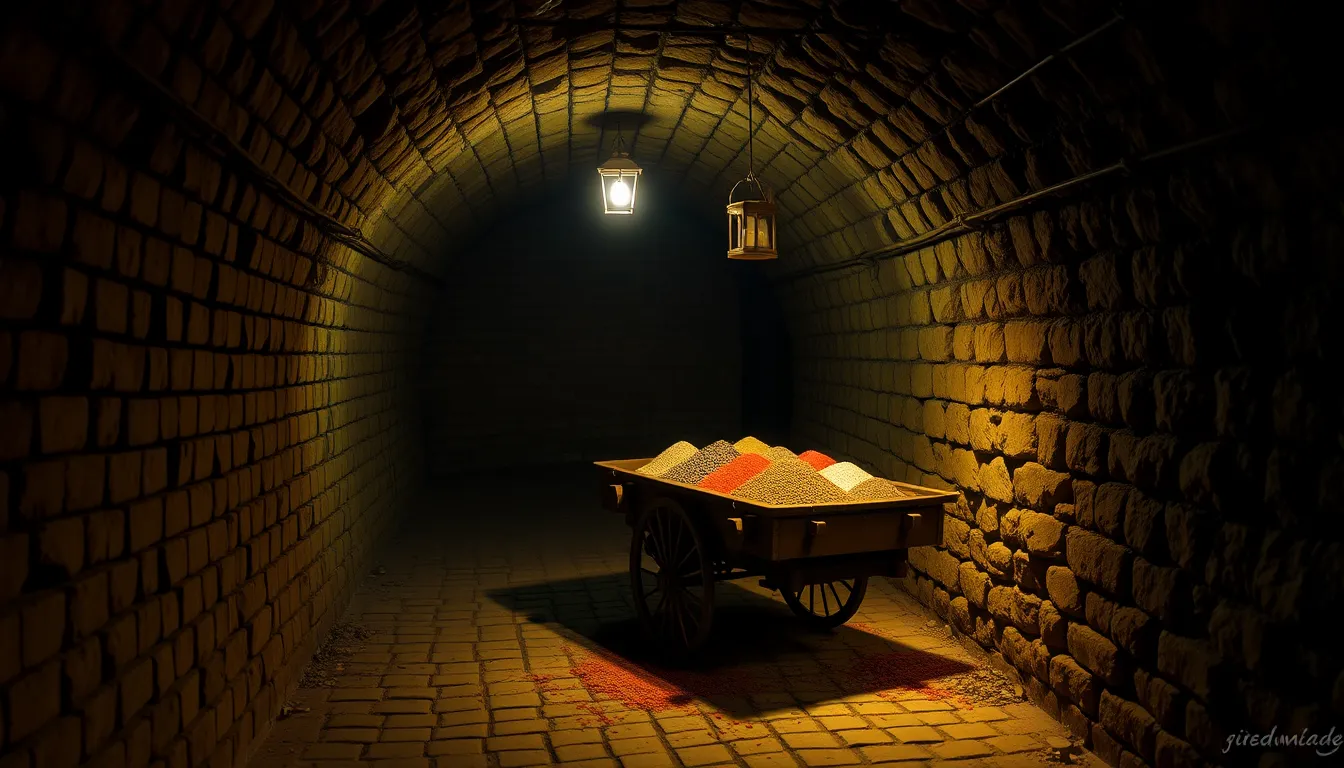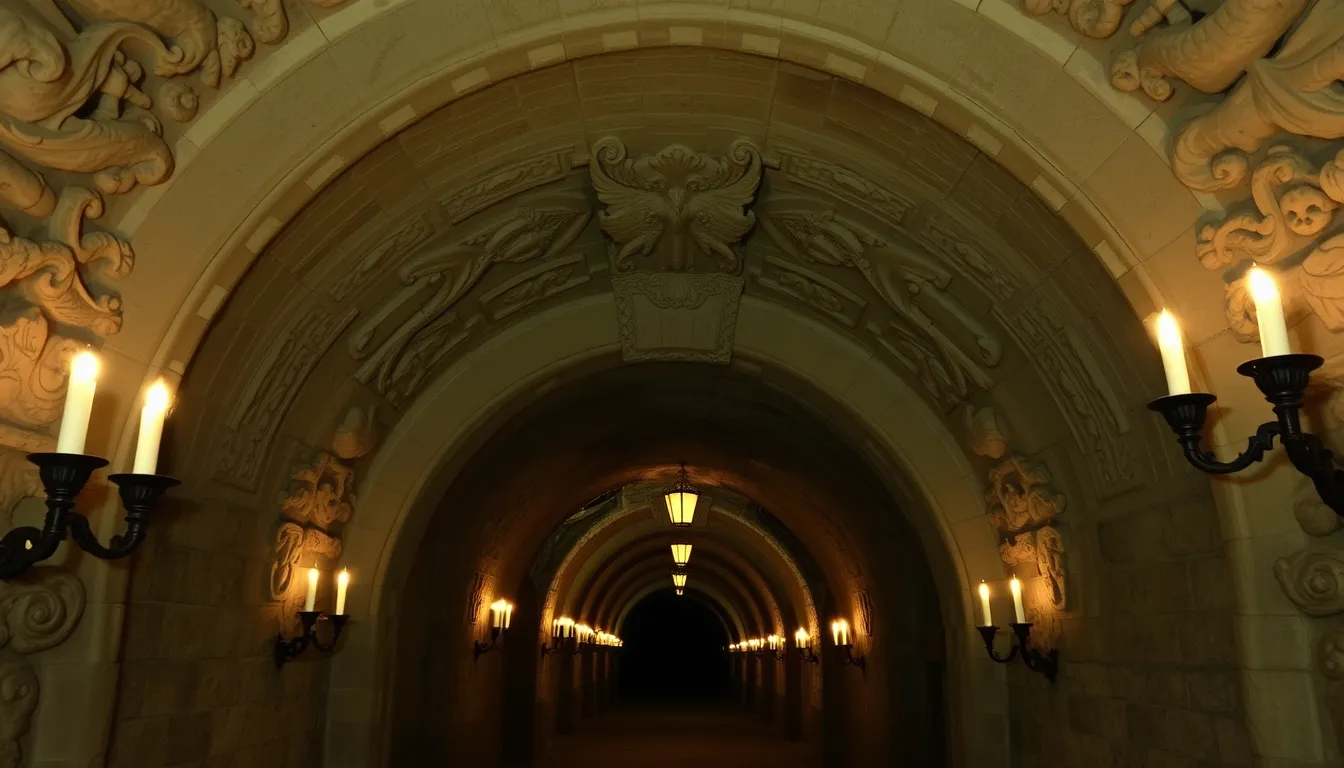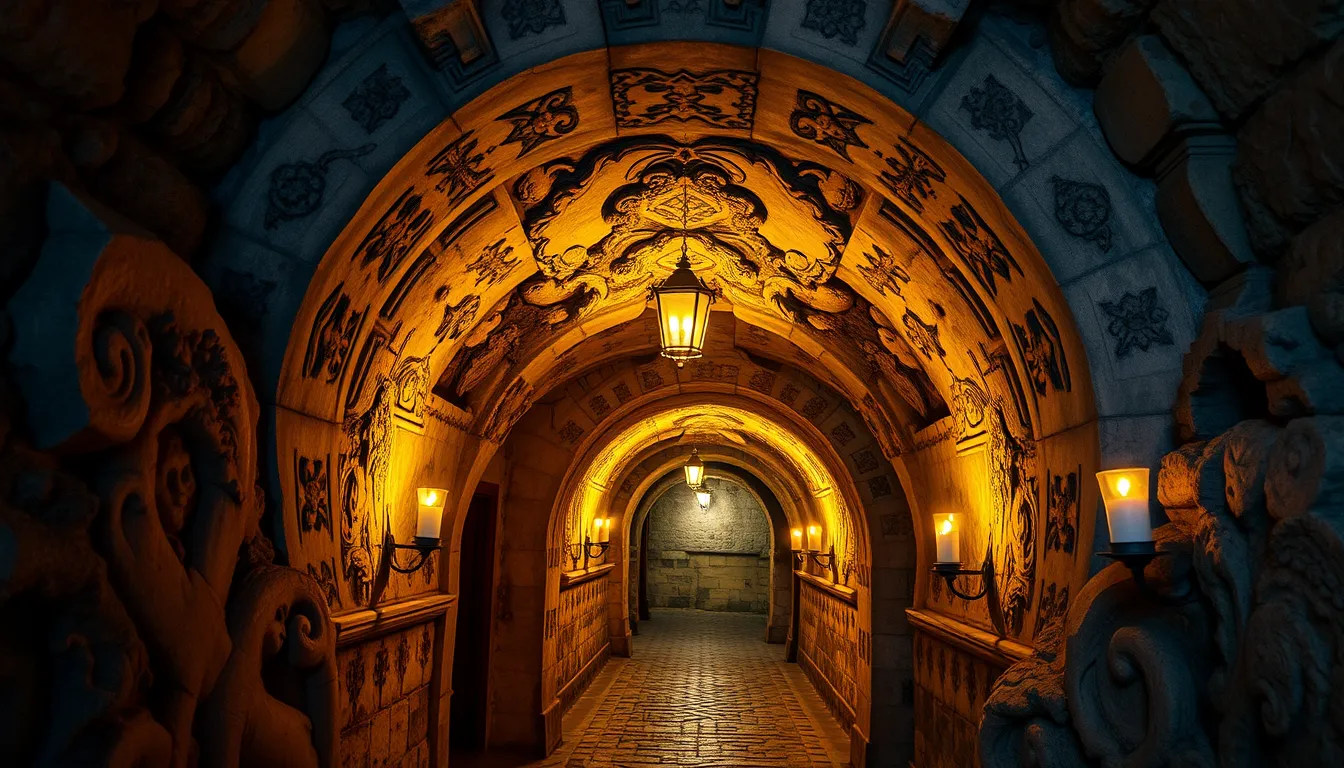Lviv, a city rich in history and cultural heritage, boasts a network of underground tunnels that date back centuries. These tunnels provide a fascinating glimpse into the past, reflecting the city’s dynamic evolution through various historical epochs. Originally crafted for utility, they reveal much more than mere architectural ingenuity; they are a testament to the resilience and resourcefulness of the people who have called Lviv home.
The earliest mention of these tunnels can be traced back to the middle ages when Lviv was a bustling trade center in the Kingdom of Galicia-Volhynia. As merchants and travelers flocked to the city, a need arose for defensive measures and secure pathways between key buildings, prompting the construction of this subterranean network.
Over the centuries, the tunnels adapted to meet the changing needs of the city. During the turbulent times of wars and occupations, they served as critical escape routes and shelters, providing safety to the citizens as well as storing valuable goods. The complexity of these tunnels increased with each significant historical event, resulting in a sprawling maze that extends beneath Lviv.
Scholarly exploration of the tunnels began in the 20th century, uncovering not just their functional significance but also highlighting their architectural features. Many sections feature intricate designs that showcase the craftsmanship of different eras, ranging from medieval stonework to baroque embellishments. As urban exploration gained popularity, these tunnels became a subject of intrigue for historians, adventurers, and tourists alike, eager to uncover the mysteries hidden beneath the streets of Lviv.
Did you know? The underground network operates at various levels, with some parts reaching depths of over 30 meters (about 100 feet) below the surface.
Today, the preservation and exploration of Lviv’s underground tunnels are crucial for maintaining their historical significance. As more people become interested in exploring these hidden passages, ongoing efforts aim to balance tourism with preservation, ensuring that the tunnels continue to tell the story of Lviv for generations to come.
The origins of Lviv’s tunnels
The origins of Lviv’s underground tunnels can be traced back to the medieval period, around the 13th century, when the city began to flourish as a major trading hub. The strategic location of Lviv made it an ideal spot for merchants traveling along important trade routes, linking East and West. As commerce thrived, the need for security and convenience led investors and city planners to consider subterranean solutions.
Early construction focused on defensive capabilities; the tunnels were designed to facilitate safe passage amidst growing tensions from rival factions and invading forces. Notably, the Great Hall of the Old City Hall is believed to connect with nearby tunnels, demonstrating that significant buildings were often linked to this underground network for both safety and efficiency. Constructed largely out of limestone, these tunnels exhibit robust engineering techniques, indicating that the builders possessed considerable craftsmanship and architectural knowledge.
The tunnels served multiple purposes throughout their history. Initially, they functioned as escape routes during sieges or raids, enabling residents to flee without crossing the dangerous streets above. Additionally, they provided a safe haven for storing goods, helping merchants protect their wares from theft or destruction during conflicts. Over time, as the city’s political landscape shifted, the tunnels adapted yet again; they became centers for clandestine meetings or smuggling operations during periods of increased oppression.
As Lviv experienced numerous changes—through wars, occupations, and transitions in governance—the tunnels evolved, expanding and intertwining beneath the city. The intricate layout showcases how the needs and aspirations of Lviv’s inhabitants spurred continuous development. Some sections feature vaulted ceilings and arches reminiscent of Romanesque architecture, while others bear the hallmarks of later styles, indicating both a chronological timeline and artistic evolution.
The fascination with Lviv’s origins has only heightened in recent years as excavations continue to reveal more about its enigmatic passageways. Historians and archaeologists are collaborating to document these tunnels meticulously, ensuring that each discovery adds depth to the narrative of the city’s past. Tours of the tunnels have become a popular attraction, allowing visitors to experience the underground world and gain insight into Lviv’s historical significance.
| Key Features of Lviv’s Tunnels | Era of Architecture |
|---|---|
| Vaulted ceilings | Romanesque |
| Intricate carvings | Gothic |
| Baroque embellishments | Baroque |
| Escape routes | Medieval to modern |
Fun Fact: It is estimated that the total length of Lviv’s underground tunnels exceeds 100 kilometers, creating a vast labyrinth under the city.
Each layer unearthed not only contributes to our understanding of Lviv’s past but also emphasizes the need for thoughtful preservation practices. As urban exploration becomes increasingly popular, it is essential to safeguard these historical assets while also allowing future generations to appreciate the significance of these ancient tunnels.
Architectural marvels beneath the city
Descending into the depths of Lviv, one is instantly transported into a realm where history and artistry meld seamlessly. The architectural marvels found within these underground tunnels offer a breathtaking testament to the ingenuity and versatility of their creators. The intricate designs and structural components reflect not only the functional needs of the time but also the artistic expressions and aspirations of the city’s builders.
As visitors wander through the tunnels, they will encounter stunning vaulted ceilings that speak to the Romanesque period. These remarkable arches, crafted from local limestone, showcase the skill and craftsmanship of the builders who meticulously shaped each stone. The sheer elegance of these structures offers a stark contrast to the hustle and bustle of the city above, providing a calm space rich in historical significance.
In other segments of the tunnels, one can observe Gothic influences in the form of detailed carvings and ribbed vaults. These features hint at the evolving architectural styles that overlaid the foundations of Lviv’s rich history. The passing years and changing tastes have left an indelible mark on the tunnels. For instance, during the Baroque era, embellishments were added, infusing these spaces with ornate details designed to captivate the senses. The accommodation of different architectural styles within the tunnels not only illustrates their adaptability but also represents the overarching narrative of Lviv’s historical evolution.
The design of these tunnels was not solely based on aesthetic values; practicality was key in their conception. In many instances, the tunnels served as conduits for critical utilities. They facilitated the transportation of goods between markets and storage areas underground, allowing merchants to operate discreetly amidst the chaotic street life above. This dual function—a harmonious blend of form and function—underscores the tunnels’ significance in the daily lives of Lviv’s inhabitants across the ages.
In terms of preservation, certain parts of the tunnels remain remarkably intact, thanks in part to the natural soil that provides insulation and protection. However, the delicate balance between conservation and exploration remains a challenge that modern-day Lviv faces. As urban exploration thrives and more enthusiasts seek to uncover the city’s mysterious passages, careful management strategies are vital to ensure these architectural wonders do not succumb to wear and tear.
| Architectural Styles Found in Lviv’s Tunnels | Features |
|---|---|
| Romanesque | Vaulted ceilings, sturdy arches |
| Gothic | Dramatic ribbed vaults, intricate stone carvings |
| Baroque | Ornate details, elaborate decorations |
| Utility design | Trade passages, storage rooms |
Curious Fact: Some of the tunnels even feature remnants of ancient graffiti, providing glimpses into the thoughts and lives of those who traversed these passages long before.
Each corner of the underground network holds stories waiting to be uncovered, making exploration not just a journey through space but through time itself. Lviv’s tunnels serve as a brilliant window into the city’s past, reflecting how art, architecture, and practicality have coalesced to create a unique underwater world filled with wonder.
The purpose and use of the tunnels

Lviv’s underground tunnels have served various purposes throughout history, shaped by the needs of the city’s inhabitants and the ever-evolving socio-political landscape. Initially constructed for safety and security, the tunnels allowed citizens to navigate the city’s dangers during times of conflict or unrest. As a sanctuary from external threats, they provided essential refuge, enabling merchants and families alike to transport goods or escape the turmoil above.
Beyond their defensive roles, the tunnels became vital for the economic fabric of Lviv. Merchants used these underground networks to move valuable products discreetly. This underground commerce minimized exposure to thieves and hostile forces while maintaining the flow of trade that was crucial to the city’s vitality. The shadowy paths below the vibrant streets also acted as storage facilities, safeguarding agricultural products and precious commodities from potential destruction during sieges.
In addition to their commercial use, the tunnels fostered a culture of secrecy and intrigue. Over centuries of turmoil, they transformed into sites for clandestine meetings and discussions among political dissidents, allowing individuals to plot and organize away from prying eyes. Many local legends recount tales of secret societies operating within the tunnels, weaving together the history of resistance against oppressive forces. These narratives have become part of Lviv’s captivating folklore.
Remarkable Insight: Some of Lviv’s most influential historical figures allegedly used these tunnels for strategic discussions and planning, illustrating their importance beyond mere architecture.
During World War II, the tunnels once again demonstrated their utility. Many people sought refuge in the underground passages, where they could evade the chaos erupting above. The network sustained a community in times of dire need, showcasing the resilience of Lviv’s citizens. Even today, those who explore these tunnels can feel echoes of the struggles faced by previous generations, lending a weight to their historical significance.
The adaptability of Lviv’s tunnels is notable as they have evolved alongside the city. They not only embraced their roles as protective shelters and transport avenues but also expanded to offer unique spaces for social gatherings and cultural exchanges. Today, certain segments of the tunnels are open to visitors, inviting them to experience the historical context blended with the vibrant present of Lviv. The city has embraced this underground heritage, promoting guided explorations that delve into the stories etched in the stone walls.
| Purposes of Lviv’s Tunnels | Description |
|---|---|
| Safety and Refuge | Provided shelter during sieges and raids |
| Trade and Commerce | Facilitated discreet movement of goods |
| Secretive Meetings | Served as sites for clandestine operations |
| Community Resilience | Supported citizens during challenging times |
Historical Highlight: The Lviv Historical Museum has even showcased artifacts found in the tunnels, highlighting their role in the city’s vibrant past.
The significance of these tunnels cannot be understated. They are a testament to the city’s dynamic history, reflecting how Lviv has adapted to and thrived in the face of adversity. Today, as urban exploration grows in popularity, the tunnels continue to serve as a living history lesson, enticing adventurous souls to wander through their darkened paths while uncovering the layers of stories woven into their existence.
Legends and myths surrounding the tunnels
Throughout the centuries, tales of ghosts, hidden treasures, and mysterious creatures have become intertwined with the history of Lviv’s underground tunnels, transforming them into a canvas for local legends and folklore. These stories, often shared by locals and passed down through generations, enrichers the experience of those who dare to venture into the depths beneath the city.
One of the most popular legends speaks of the “White Lady,” a ghostly figure said to roam the tunnels. According to the tale, she was a tragic figure who lost her life centuries ago under mysterious circumstances, wandering the passages in search of her lost love. Visitors who report experiencing a sudden chill or an unexplained presence claim she is still searching for closure among the echoing stone walls. The legend serves as a vivid reminder that the past continues to linger in the shadows of Lviv.
Another engaging myth involves hidden treasures believed to be hidden within the labyrinth. It is said that during times of turmoil, wealthy merchants and citizens buried their valuables deep within the tunnels, hoping to protect them from looters and invaders. Some adventurers, enchanted by the whispers of these stories, have attempted to rediscover lost fortunes. Though many have scoured the tunnels in search of these fabled treasures, none have reported finding anything of great worth—at least, not yet.
Mysterious symbols and markings supposedly adorn the walls of these dark corridors, fueling theories about ancient societies and secret cults that once thrived in the city. Among these theories is the notion that Lviv’s underground system served as a meeting ground for clandestine groups aiming to influence the events that shaped the region. These beliefs have only added to the intrigue surrounding exploration of the tunnels, compelling both historians and thrill-seekers to delve deeper into the mysteries they hold.
Spooky Encounter: Those who have explored the tunnels often say that strange noises can be heard echoing through the passageways, leading some to believe that the spirits of the past are still present.
Moreover, some locals recount stories of encounters with otherworldly creatures said to inhabit the tunnels. In the depth of night, echoing footsteps and strange whispers sometimes accompany the stale air, prompting narratives about guardians of unspeakable secrets or protectors of ancient knowledge hidden away from the eyes of the living. Such tales enhance the adventurous aspect of navigating this underground realm, as explorers often feel the weight of history and the spirit of those who walked these passages before them.
The melding of legends with the reality of Lviv’s historical significance creates an educational and exciting experience for those drawn to explore these hidden depths. The mix of fantasy and factual history shapes how both locals and tourists approach the tunnels, navigating them not only as physical spaces but as cultural relics steeped in the rich mythology of Lviv.
| Famous Legends Associated with Lviv’s Tunnels | Description |
|---|---|
| The White Lady | A ghost seeking her lost love |
| Hidden Treasures | Wealth hidden to escape looting |
| Ancient Symbols | Markings suggesting secret societies |
| Otherworldly Creatures | Legends of guardians of the tunnels |
These rich narratives alongside Lviv’s intricate tunnel system make every visit a blend of adventure and learning, as each twist and turn perhaps leads to an encounter with the unseen duality of history and legend. Thus, Lviv’s tunnels not only serve as a significant backdrop for understanding the city’s past but also enhance the experience of exploration by merging reality with the realm of the fantastical.
Preservation efforts and future explorations
In recent years, the preservation of Lviv’s underground tunnels has become a focus for urban planners, historians, and conservationists alike. As the city embraces its vast historical heritage, efforts to protect these delicate structures are vital. Initiatives are underway to carefully monitor the condition of the tunnels and mitigate the impact of increasing tourism. This is particularly important because unchecked exploration without proper guidelines could lead to irreversible damage to these historical assets.
To facilitate responsible exploration, local organizations and authorities have begun implementing structured tours that educate visitors about the significance of the tunnels while emphasizing the need for protection. Guided tours not only unveil the mysteries of the tunnels but also highlight the stories of the craftsmen who built them, thus fostering a greater appreciation for their historical and architectural value. By engaging with residents and cultivating a sense of community around these spaces, the city can nurture a culture of respect and guardianship over its underground legacy.
In terms of practical preservation efforts, the city has invested in research and restoration projects aimed at documenting the tunnels’ current conditions and understanding their structural integrity. This often involves collaboration with universities and research institutions, drawing knowledge from various fields such as architecture, archaeology, and history. Some tunnels are subject to archaeological excavations that explore their origins, potentially uncovering artifacts that paint a clearer picture of their past uses and importance. These findings can open new avenues for historical understanding and compel further preservation practices to be put in place.
| Preservation Initiatives in Lviv | Description |
|---|---|
| Structured Tours | Guided explorations to educate visitors about historical significance |
| Community Engagement | Involving locals in preserving and promoting underground heritage |
| Research Collaborations | Partnerships with universities for documentation and study |
| Archaeological Excavations | Uncovering historical artifacts to enhance understanding |
Looking towards the future, the potential for exploring and utilizing Lviv’s tunnels expands as technology and conservation methods evolve. Innovations in monitoring techniques allow experts to assess the health of these underground structures with precision, ensuring that preservation efforts can respond proactively to any potential threats. Advances in virtual reality might also pave the way for immersive experiences, allowing those unable to access the tunnels to explore these historical spaces from afar. Such technologies can enhance public interest and awareness, inspiring further appreciation of Lviv’s remarkable underground heritage.
Insightful Note: A balanced approach to preservation and exploration is crucial to ensure that these tunnels remain an integral part of Lviv’s allure for future generations.
As exploration continues, Lviv’s tunnels are poised to reveal even more secrets hidden within their ancient walls. With the combined efforts of the city, the community, and dedicated enthusiasts, the preservation of Lviv’s fascinating underground tunnels can thrive, ensuring that this intricate network continues to tell the stories of those who once roamed its passages.


